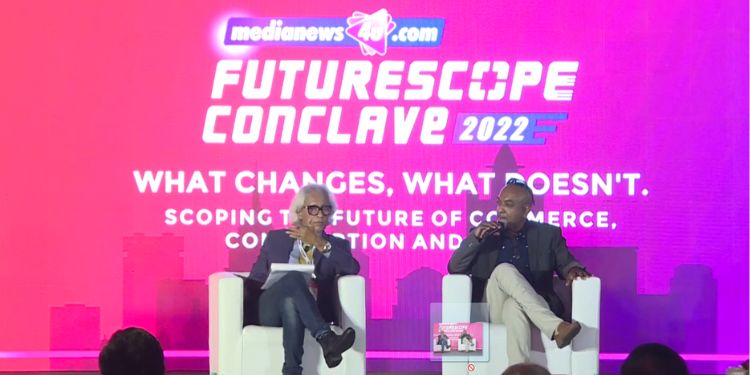In a one-on-one interaction at the inaugural Medianews4u.com Futurescope Conclave in Bengaluru on 15th July with Consulting Editor Gokul Krishnamoorthy, Dr. Bhaskar Das, Director – Content, Yunometa, and Professor and Mentor, Centre for Entertainment and Media Studies, MICA, reflected on a range of topics related to the subject of his talk: ‘The Future of Entertainment’.
Edited excerpts:
The recent IPL media rights auction opened us up to a new reality. Digital rights for India were picked up at Rs.50 crore per match, very close to broadcast rights at Rs.54.5 crore per match. This represents a huge jump from the previous numbers (specifically on digital), raising questions on viability for the rights holder – there is a huge gap between current revenue and revenue needed to rake in profit. Will subscribers pay up to bridge the gap – both on TV and digital? Will advertisers be willing to fund the premium?
Dr. Bhaskar Das: I’m a cricket fan. So my answer will be biassed. But the fact remains that two more franchisees have joined. I have seen all the matches. Two and a half hours, no cost, you have fun and entertainment. I know it looks like completely irrational exuberance when it comes to prices. Mukesh bhai, I trust. He has intentionally not gone for the linear TV rights and gone for digital. It must be right. See what has happened to Jio. Hotstar will get affected because 60 to 70 pc of the traffic used to come from IPL.
Linear will be tough, for a reason – we think that 80pc of India will be single television households. But today everyone from kids to drivers see videos on their mobiles; there are over 500 million smartphones. During IPL, other genres of television suffer. Why do they suffer? Because you are not playing the game in view of the changed circumstances. Why do we not want to miss Korean content in spite of the availability of long-running Saas-Bahu serials?
I feel there will be a challenge initially. But knowing BCCI and knowing the Indian audience, it is aam junta ka entertainment, two and a half hours of unadulterated fun. The advertising market is still growing. The affected parties during that period will always be the other media.
I have a feeling they will get the revenue. Because they are continuously innovating to create sustained interest in cricket. I will add only one caveat. I am not sure whether the post ‘90s born gen is that crazy about cricket as it is about soccer, F1 or gaming.
Gaming companies have spent over Rs.600 crore advertising on IPL. The type of sponsors are not the usual suspects.
Rising heft of regional content – is it a trend or a flash in the pan?
There is no question of this being a flash in the pan. Bollywood stars are in deep trouble. There is a tremendous future for regional language movies. The mistake that Netflix did, is they thought India is only five metros. If you look at Marathi and Bengali films, they are rocking. Look at how many followers HoiChoi has. Look at the Kannada and Telugu films like RRR, Pushpa and KGF.
Bollywood needs to smell the coffee. You have to play the new game. Even on OTT, we see many Bollywood films bombing. But we also see unknown films and unknown directors rocking. Niche films across languages are doing well.
I have a feeling regional films are doing well not just among diaspora but also among non-Indians. I am not saying it’s in the league of Korean content. That is in a different league.
Incidentally, how did Korean content kick off? It all started in 2012, with Gangnam Style. None of you perhaps know that it started with Manipur. There is a revolutionary organisation in Manipur, which banned Bollywood films. So they had no entertainment. They started looking at entertainment and found Korean entertainment quite helpful. Today more people in Manipur know Korean than Hindi. It is scary. We did some research when I was with ZEE to start a Korean-dubbed channel. Now, Korean language learning has come to the metros too. There are Korean food shops in Pune, Korean restaurants in Delhi.
What is the core point they are trying to say? What is BTS trying to say? I Purple – you love yourself, you love the way you are. This creates a new level of confidence. Sophia’s is a decent college in Mumbai. There are communities there for Korean webseries, films, pop, webtoons. What is the reason for it? They have decoded the universality of human emotions. Our TV serials run for 54 episodes. They are ruthless about 16.
Content like Patal Lok, Sacred Games worked across markets. Manikaarnika had worked well in Japan. Different films are working in different markets. Understanding the market, differentiation and marketing makes the difference. To my mind, regional content has a definite future; there is no doubt about that in the Indian context. Hindi (cinema) has enough reason to be anxious.
What was the impact of Covid and OTT in catalysing regional content’s rise?
Definitely, Covid might have precipitated it but it is also precipitated by technology that is available. Today, unknown artistes who don’t otherwise get opportunities in Bollywood, get a platform. Who would produce a Bandish Bandits in Bollywood? In terms of narrowcasting by interest level, regional platforms are very good and OTT is facilitating that big time. There are several niches of content that are emerging. OTT is acting as a catalyst in different kinds of content being dished out to consumers.
What happens to the OTT long tail? Some say they are waiting for the right bid…
That’s true for any industry. The whole concept of valuation is common. Anything is fair in business and love – and war perhaps, for Mr Putin.
The important point here is that everyone is working for multiple business models. There is free, freemium, hybrid and so on. In the growth phase, people focused only on the acquisition of customers, even if there was high churn. The time for consolidation has come, not in terms of merging, but in terms of focus on profitability. It does not matter if the numbers are less. Quality is more important than quantity. The current trend is dominated by chasing of numbers. The very fact that Netflix has tied up with Microsoft is to help them with their AVOD model. But they can also help with the SVOD model. There are seven or eight models at work. I don’t know who is making money. But content is the king here, distribution is queen. Then of course there is monetisation.
But consumer culture has changed forever. The Covid-time behaviour is going to stay forever. The consumer will not change.
You say people do not want to see ads and that any business model that is overdependent on ads is bound to fail. Isn’t the general Indian mindset one of not minding ads as long as the content is free or discounted?
That is not true. You have to deaverage customers. Who are we talking about? There is something called cohort-based content creation. Different cohorts have different behaviours. We always think that consumers will not pay.
If you segment consumers from the super rich to destitute, there is the lower middle class. Now, TV is free to air (DD). TV is also going premium. A generic statement like ‘Indians do not want to pay’ is most irrelevant.

















